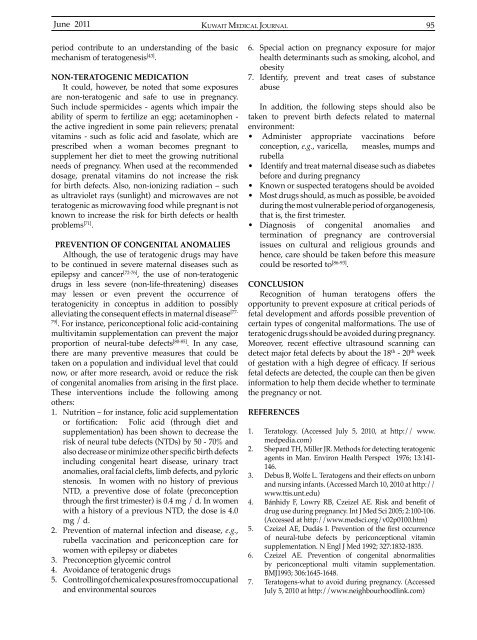Vol 43 # 2 June 2011 - Kma.org.kw
Vol 43 # 2 June 2011 - Kma.org.kw
Vol 43 # 2 June 2011 - Kma.org.kw
You also want an ePaper? Increase the reach of your titles
YUMPU automatically turns print PDFs into web optimized ePapers that Google loves.
<strong>June</strong> <strong>2011</strong><br />
KUWAIT MEDICAL JOURNAL 95<br />
period contribute to an understanding of the basic<br />
mechanism of teratogenesis [<strong>43</strong>] .<br />
NON-TERATOGENIC MEDICATION<br />
It could, however, be noted that some exposures<br />
are non-teratogenic and safe to use in pregnancy.<br />
Such include spermicides - agents which impair the<br />
ability of sperm to fertilize an egg; acetaminophen -<br />
the active ingredient in some pain relievers; prenatal<br />
vitamins - such as folic acid and fasolate, which are<br />
prescribed when a woman becomes pregnant to<br />
supplement her diet to meet the growing nutritional<br />
needs of pregnancy. When used at the recommended<br />
dosage, prenatal vitamins do not increase the risk<br />
for birth defects. Also, non-ionizing radiation – such<br />
as ultraviolet rays (sunlight) and microwaves are not<br />
teratogenic as microwaving food while pregnant is not<br />
known to increase the risk for birth defects or health<br />
problems [71] .<br />
PREVENTION OF CONGENITAL ANOMALIES<br />
Although, the use of teratogenic drugs may have<br />
to be continued in severe maternal diseases such as<br />
epilepsy and cancer [72-76] , the use of non-teratogenic<br />
drugs in less severe (non-life-threatening) diseases<br />
may lessen or even prevent the occurrence of<br />
teratogenicity in conceptus in addition to possibly<br />
alleviating the consequent effects in maternal disease [77-<br />
79]<br />
. For instance, periconceptional folic acid-containing<br />
multivitamin supplementation can prevent the major<br />
proportion of neural-tube defects [80-85] . In any case,<br />
there are many preventive measures that could be<br />
taken on a population and individual level that could<br />
now, or after more research, avoid or reduce the risk<br />
of congenital anomalies from arising in the first place.<br />
These interventions include the following among<br />
others:<br />
1. Nutrition – for instance, folic acid supplementation<br />
or fortification: Folic acid (through diet and<br />
supplementation) has been shown to decrease the<br />
risk of neural tube defects (NTDs) by 50 - 70% and<br />
also decrease or minimize other specific birth defects<br />
including congenital heart disease, urinary tract<br />
anomalies, oral facial clefts, limb defects, and pyloric<br />
stenosis. In women with no history of previous<br />
NTD, a preventive dose of folate (preconception<br />
through the first trimester) is 0.4 mg / d. In women<br />
with a history of a previous NTD, the dose is 4.0<br />
mg / d.<br />
2. Prevention of maternal infection and disease, e.g.,<br />
rubella vaccination and periconception care for<br />
women with epilepsy or diabetes<br />
3. Preconception glycemic control<br />
4. Avoidance of teratogenic drugs<br />
5. Controlling of chemical exposures from occupational<br />
and environmental sources<br />
6. Special action on pregnancy exposure for major<br />
health determinants such as smoking, alcohol, and<br />
obesity<br />
7. Identify, prevent and treat cases of substance<br />
abuse<br />
In addition, the following steps should also be<br />
taken to prevent birth defects related to maternal<br />
environment:<br />
• Administer appropriate vaccinations before<br />
conception, e.g., varicella, measles, mumps and<br />
rubella<br />
• Identify and treat maternal disease such as diabetes<br />
before and during pregnancy<br />
• Known or suspected teratogens should be avoided<br />
• Most drugs should, as much as possible, be avoided<br />
during the most vulnerable period of <strong>org</strong>anogenesis,<br />
that is, the first trimester.<br />
• Diagnosis of congenital anomalies and<br />
termination of pregnancy are controversial<br />
issues on cultural and religious grounds and<br />
hence, care should be taken before this measure<br />
could be resorted to [86-93] .<br />
CONCLUSION<br />
Recognition of human teratogens offers the<br />
opportunity to prevent exposure at critical periods of<br />
fetal development and affords possible prevention of<br />
certain types of congenital malformations. The use of<br />
teratogenic drugs should be avoided during pregnancy.<br />
Moreover, recent effective ultrasound scanning can<br />
detect major fetal defects by about the 18 th - 20 th week<br />
of gestation with a high degree of efficacy. If serious<br />
fetal defects are detected, the couple can then be given<br />
information to help them decide whether to terminate<br />
the pregnancy or not.<br />
REFERENCES<br />
1. Teratology. (Accessed July 5, 2010, at http:// www.<br />
medpedia.com)<br />
2. Shepard TH, Miller JR. Methods for detecting teratogenic<br />
agents in Man. Environ Health Perspect 1976; 13:141-<br />
146.<br />
3. Debus B, Wolfe L. Teratogens and their effects on unborn<br />
and nursing infants. (Accessed March 10, 2010 at http://<br />
www.ttis.unt.edu)<br />
4. Bánhidy F, Lowry RB, Czeizel AE. Risk and benefit of<br />
drug use during pregnancy. Int J Med Sci 2005; 2:100-106.<br />
(Accessed at http://www.medsci.<strong>org</strong>/v02p0100.htm)<br />
5. Czeizel AE, Dudás I. Prevention of the first occurrence<br />
of neural-tube defects by periconceptional vitamin<br />
supplementation. N Engl J Med 1992; 327:1832-1835.<br />
6. Czeizel AE. Prevention of congenital abnormalities<br />
by periconceptional multi vitamin supplementation.<br />
BMJ1993; 306:1645-1648.<br />
7. Teratogens-what to avoid during pregnancy. (Accessed<br />
July 5, 2010 at http://www.neighbourhoodlink.com)
















